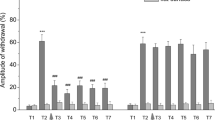Abstract
The mechanisms of some short-term non-associative learning processes, such as habituation and sensitization (or dishabituation) have been analyzed in detail in the defensive withdrawal reflex of the gill and the siphon of Aplysia. It has been shown that behavioral sensitization results from heterosynaptic facilitation of transmitter output on the mechanosensory neurons of the abdominal ganglion that innervate the gill and the siphon. The facilitation of synaptic output between sensory and motor neuron is mediated by two sets of neurons so far identified as the L28 and L29 cells which take contacts with terminal branches of sensory neurons. Serotonin as well as peptide transmitters (small cardioactive peptides SCPa and SCPb) or other unknown transmitters converge to produce synaptic facilitation in the sensory neurons via different receptors triggering a common molecular chain of events to produce the same modulatory effect. The transmitter released activates an adenylate cyclase which increases the intracellular level of cAMP (Brunelli et al. 1976). This enhancement leads to a cAMP-dependent protein phosphorilation through a protein kinase activation which induces a suppression of a specific K+ current. The block of K+ current is thought to cause broadening of the presynaptic action potential and therefore a prolonged influx of Ca++ in the presynaptic terminal which potentiates the transmitter release (Kandel and Schwartz 1982).
Access this chapter
Tax calculation will be finalised at checkout
Purchases are for personal use only
Similar content being viewed by others
References
Belardetti F, Biondi C, Colombaioni L, Brunelli M, Trevisani A (1982) Role of serotonin and cyclic AMP on facilitation of the fast conducting system activity in the Hirudo medicinalis. Brain Res 246: 895–103
Biondi C, Belardetti F, Brunelli M, Portolan A, Trevisani A (1982) Increased synthesis of cyclic AMP and short-term plastic changes in the segmental ganglia of the leech, Hirudo m. Cell Mol Neurobiol 2: 81–91
Brunelli M, Castellueci V, Kandel ER (1976) Synaptic facilitation and behavioral sensitization in Aplysia: possible role of serotonin and cAMP. Science 194: 1178–1181
Kandel ER, Schwartz JH (1982) Molecular biology of learning: modulation of transmitter release. Science 218: 433–443
Author information
Authors and Affiliations
Editor information
Editors and Affiliations
Rights and permissions
Copyright information
© 1986 Springer-Verlag Berlin Heidelberg
About this paper
Cite this paper
Brunelli, M., Demontis, G., Traina, G. (1986). Serotonin and cAMP Mediate Plastic Changes in Swimming Activity of Hirudo m . In: Montalcini, R.L., Calissano, P., Kandel, E.R., Maggi, A. (eds) Molecular Aspects of Neurobiology. Proceedings in Life Sciences. Springer, Berlin, Heidelberg. https://doi.org/10.1007/978-3-642-70690-5_3
Download citation
DOI: https://doi.org/10.1007/978-3-642-70690-5_3
Publisher Name: Springer, Berlin, Heidelberg
Print ISBN: 978-3-642-70692-9
Online ISBN: 978-3-642-70690-5
eBook Packages: Springer Book Archive




